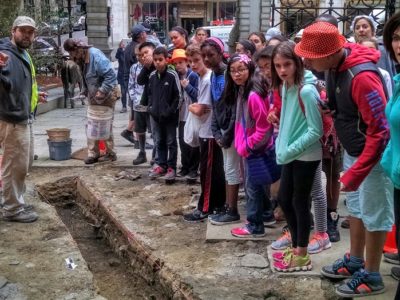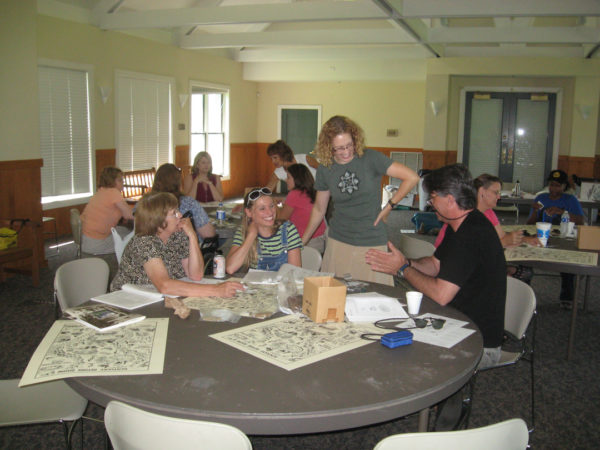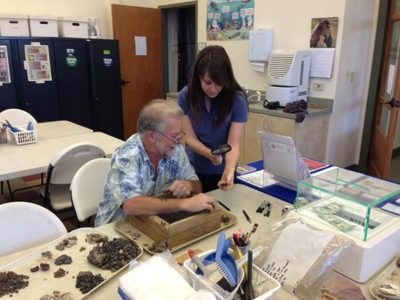
What’s the Role of Archaeology in Education Curricula? Project Archaeology: Investigating a Shotgun House
By: M. Jay Stottman
Kentucky Archaeological Survey

Although teachers have sought archaeological information to supplement their curricula for decades, it has only been within the last twenty years that archaeologists have made a concerted effort to introduce their research to educators through archaeology-based content and activities. Much of this work has privileged an archaeological perspective that is largely focused on archaeological research and stewardship. The goal of such a perspective focuses on promoting a better understanding of what archaeologists do, how important that work is, and preserving archaeological resources. The Project Archaeology: Investigating a Shotgun House curriculum, developed by the Kentucky Archaeological Survey and Project Archaeology, considers archaeology and its role in education differently. The goals of this curriculum are based on activist perspectives in archaeology where community needs are given equal weight to those of archaeology. In education, this perspective is less about the specific needs and issues of archaeology and more about how archaeology can be used to help teachers teach. In other words, archaeology is a vehicle for teaching rather than just what is being taught.
Because archaeology is inherently evidence-and inquiry-based, the focus of the Project Archaeology: Investigating a Shotgun House curriculum, as with other Investigating Shelter case studies, is on the process of archaeology, not just the products of research. The process by which archaeologists do their work is a great way to engage students in learning about and applying the skills of inquiry by developing research questions, collecting evidence, and making interpretations. Through this process students learn about the relationship of objects to people in different contexts, which highlights human intelligence, ingenuity, innovation, and agency. They learn about a variety of humanities topics, such as class, race, ethnicity, and community. The lessons and activities in the curriculum are focused on this process and are derived specifically from archaeological research of a shotgun house in the Davis Bottoms neighborhood of Lexington, Kentucky. The people of this marginalized neighborhood are diverse, but they share the class and condition of poverty, from which they had built a tight knit community. The impetus for the archaeological research, a highway project, led to a present day battle for community identity and social justice.

Archaeologist Lori Stahlgren Works with Teachers at a Project Archaeology Workshop (by author, 2009).
The activist perspective used in the development of this curriculum and the real story about the Davis Bottom resident’s plight connects the study of the past with present day issues of civic engagement and social and environmental justice. Not only do students learn about the process of inquiry, but they learn about the history and development of a marginalized community and how they can relate to its people. They also are encouraged to become informed civic decision makers and to seek ways to take action. The role of archaeology from this perspective prioritizes teaching the skills of inquiry, understanding that evidence is important, that the past informs the present, and becoming civically engaged.
So has this perspective abandoned the needs of archaeology? Not necessarily, with the use of archaeology as a vehicle to teach inquiry, students gain an understanding of and a respect for archaeology, which allows for the consideration of archaeological ethics and stewardship. The difference is that our archaeological goals are less overt than more direct stewardship messaging. Through the curriculum teachers and students discover the importance of archaeological research and stewardship for themselves. So what is the role of archaeology in education? Should it be primarily to promote archaeological needs and issues? Should it be to primarily serve students and teachers? Should it be both? These questions create a bit of philosophical tension regarding the goals of archaeology and our control of it. Should we consider educational and archaeological goals equally? Should we always be overt in our preservation messages when using archaeology in education?
To learn more about Project Archaeology and the Investigating Shelter Curriculum visit www.projectarchaeology.org
To learn more about the Davis Bottoms Neighborhood project visit: https://anthropology.as.uky.edu/kas/kas-projects/davis-bottom-project
Henderson, A. Gwynn, M. Jay Stottman, Robin L. Jones, and Linda S. Levstik
2016 Project Archaeology Investigating a Shotgun House: A Curriculum Guide for Grades 3 through 5. Kentucky Archaeological Survey, Lexington and Project Archaeology, Bozeman, MT.




